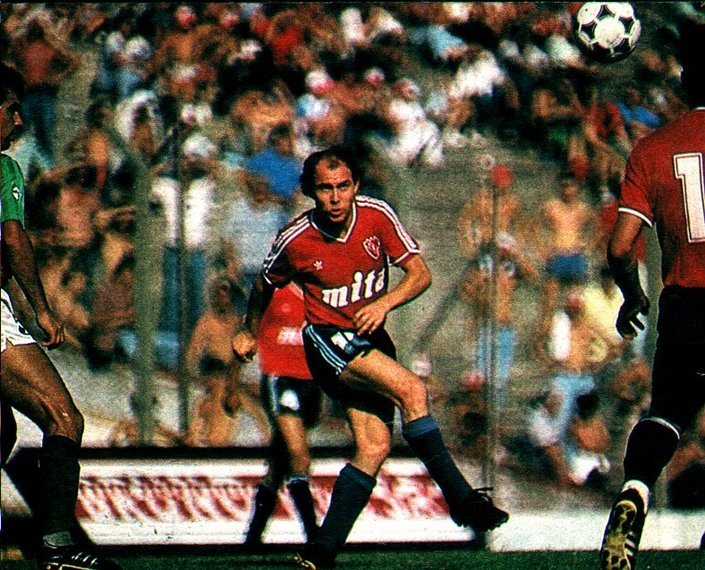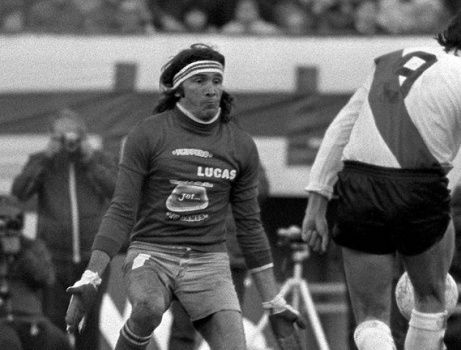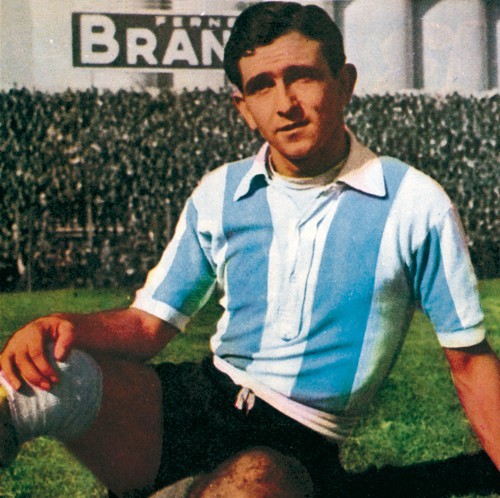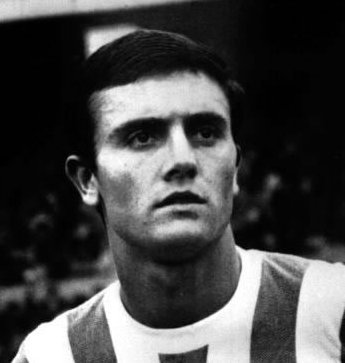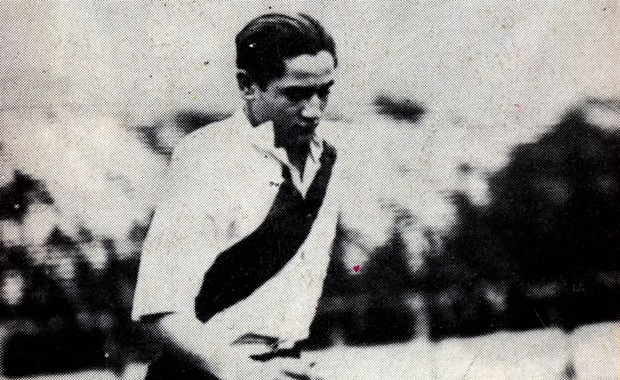FIVE GREAT ARGENTINES YOU'VE NEVER HEARD OF
But hey, you're smart, maybe you have....
On Friday, In Bed With Maradona's Twitter account sought out, from its readers, the top three footballers of all time, not including the usual suspects of Pelé, Maradona, Cruyff and so on. It was only meant as a bit of fun, but my own response got me thinking. Taking Garrincha to be one of the usual suspects (an assumption which, thinking about it now, might have been somewhat generous to many casual fans), my votes went to Alfredo Di Stéfano, Ferenc Puskás and, in deference to two truly terrifying goals-per-game ratios, a toss-up between Gerd Müller and Artur Friedenreich.
My assumption that I was the only one who'd even mentioned Friedenreich having been confirmed, I wondered whether there was an article in this. Not on Friedenreich – I write about Brazil very occasionally but it's not my speciality – but on my country of residence. Any fool can give you a rundown of the top three or five Argentine footballers of all time. The nation's pedigree is such that all are names which would probably be at least in the running for inclusion in, say, a world all-time top fifty (with a good three or four arguably in the top twenty or so).
But if we exclude currently active players (which means no place for Messi or for Argentina's most capped player Javier Zanetti) and take, say, Diego Maradona, Alfredo Di Stéfano, Mario Kempes, Daniel Passarella and Gabriel Batistuta as the top five (that gives us the country's two World Cup-winning captains, the best player of the 1978 win in Kempes, Di Stéfano's incomparable versatility and European club success, and in Batistuta, the national side's all-time top goalscorer), who are the next five greatest Argentine footballers?
I should state now that I don't intend this to be a rundown of the sixth- to tenth-best Argentine footballers of all time. That would involve rather more thought and concentration than I'm prepared to put in, considering I'm writing this whilst watching Saturday afternoon/evening's Primera División action on the telly.
It is, though, going to involve looking at five great Argentine footballers. Footballers who might, depending who you listen to, deserve a place in the country's all-time top ten, but who you probably haven't heard of if you've not previously paid much attention to Argentine football. I shan't number them, as I'm not listing them in any particular order and don't wish to imply a hierarchy. So, before this introduction gets any more cumbersome, let's get to it.
Orestes Omar Corbatta
We've come full circle here. In the opening paragraph above, I mentioned Garrincha. And we start here with the man nicknamed, 'the Argentine Garrincha'. Orestes Omar Corbatta starred on the right wing for Racing between 1955 and '62, and then for Boca Juniors from '63 to '65. A four year spell with Independiente Medellín in Colombia followed, before he returned for a few years knocking around the Argentine lower divisions (beginning, I have just discovered, with San Telmo, who no longer play in the neighbourhood of the same name where I now live, but who at the time would have been based at a stadium about 400 metres from my flat).
At just five feet four inches Corbatta was even shorter than Lionel Messi is today, but by all accounts was a similarly prodigious dribbler. Playing as an outside right, he nonetheless had a fine goalscoring record, bagging 79 in 195 appearances for Racing and seven in only 18 matches for Boca Juniors. The fact he barely played for Boca was testament to the fact that by that point, alcohol consumption had already started to affect his abilities. All the same, although his time in Colombia didn't leave behind any well-kept statistics, he's remembered for scoring five goals in a single match for Independiente Medellín in an 8-3 win over Deportes Tolima.
Corbatta won two league titles with Racing, two with Boca, and two Campeonatos Sudamericanos (today known as the Copa América) with Argentina, for whom he played forty-three times and scored eighteen goals. After the disastrous World Cup campaign in Sweden in 1958, he was arguably the only player to return to his homeland with his reputation still intact. After living his last years in Racing Club's facilities whilst working with the youth teams, he died of cancer of the larynx which had been aggravated by alcohol abuse on the 6th December, 1991. One of the streets leading to Racing's stadium now bears his name.
Adolfo Pedernera
Alfredo Di Stéfano's legacy was secured in Spain thanks to his spell running the most successful single team the European Cup/Champions League has ever seen back at the very dawn of its history. What's less well-known is that he had found his way to Spain via Colombia (in an era when the Colombian league operated outside FIFA's rules and was able to attract some of the finest players of the era from all over the world) after only breaking into the team at River Plate at the age of 21.
That's not an old age by any means, but it's not especially young either. Maradona had been playing first team football for six years by the time he turned 21, and most of the greats were already fixtures in their teams by that age. So why did arguably the most complete player in the history of football not break into the first team sooner?
Adolfo Pedernera is the answer. Or rather, the team Pedernera featured in. River Plate won the Argentine championship in 1941, '42 and '45 (there was only one championship per year back then, unlike today), and did so with a side regarded, to this day, as arguably the greatest club team the country has ever seen. Dubbed La Máquina ('The Machine') by a journalist in 1942, the most famous incarnation of the five-man starting lineup actually only played together eighteen times in four years, and never against bitter rivals Boca Juniors, but the names Ángel Labruna, Félix Loustau, José Manuel Moreno, Juan Carlos Muñoz and Pedernera are etched indelibly into the memories of fans – and not only fans of River. Labruna won nine league titles in all with River and is the Argentine Primera División's second highest scorer of all time (two goals behind Arsenio Erico, who misses out being included in this article because he's Paraguayan), but Pedernera, though he didn't score as many, orchestrated the play.
And it was the play that was the thing for La Máquina. Because although the goals flowed freely, it was the style that was most important, arguably even more so than winning (three titles in six years from 1941-'46 is hardly domination of Madrid-in-the-early-European-Cup proportions). Pedernera shaped that style, and that's why he's the player who gets picked out from a five-man frontline who could have made up this entire list on their own. When he left River in 1947 to move to Atlanta, Di Stéfano was brought back from loan at Huracán and finally given a place in the team. That's how good Pedernera was; when the time came to replace him, only the best would do.
Hugo Gatti
If you're asked to list great Argentine goalkeepers, you probably won't be able to reel off very many names. Ubaldo Fillol, the man who was between the sticks during the 1978 World Cup win at home, is pretty much undisputed as the best. He only got the starter's role during that tournament, though, after an injury to Hugo Gatti, who was running neck and neck with him in the race for the job until shortly before the big day.
He's certainly the most colourful competitor to Fillol. Gatti made his debut for Atlanta in 1962, who are now in the second division after a long-awaited promotion last year, but at the time were doing very well in the Primera. A huge admirer of Muhammad Ali, Gatti shared his idol's taste for self-promotion, and was known throughout his career for his kits, which included colourful bandanas that seem to have been precursors to legendary Mexican 'keeper Jorge Campos' self-designed shirts. Gatti joined Fillol's future club River Plate in 1964, and twelve years later, after four years there followed by spells at Gimnasia La Plata and Unión de Santa Fe, he became one of few players either brave, mad or just plain good enough to get away with playing for both River and Boca Juniors during their careers.
Having alternated with the great Amadeo Carrizo during his time at River, Gatti became a first team fixture at Gimnasia, and the deserved success finally came his way at Boca. Three national championships, two consecutive Copas Libertadores and an Intercontinental Cup (in which his performance against Borussia Mönchengladbach was key in a 3-0 win) followed, and on one memorable occasion, after sweeping up an opposing attack, he dribbled to the halfway line before providing a team-mate with an assist to score the only goal of the match.
As well as saving long-range shots by trapping the ball between his heels (okay, he only did that once, at least on video), he also holds the record for most appearances in the Argentine Primera, with 775, and shares with rival Fillol the record for most penalties saved by a goalkeeper in the Argentine league (26). And as if all this wasn't enough, in 1976 he found the time to record an album.....
Ricardo Enrique Bochini
If you're familiar with my writing already, there's a fair chance you already know about the Argentine football podcast I anchor and produce, Hand Of Pod. When I started putting this piece together, I asked HOP's resident Argentine, Sebastián García, whether he thought I'd missed anyone out of my embryonic list. Seba is a lifelong Racing fan who hates their rivals Independiente so much he refuses to even buy red items of clothing – even underwear. And his immediate response was 'you can't leave Bochini out of that list.'
He was right, of course, and not only because I was a bit short of midfielders. Independiente are the most successful club in the history of the Copa Libertadores, having won it seven times, and Bochini featured in four of those wins during his nineteen year career, which was spent entirely with Independiente in spite of the fact that Bochini and his entire family are San Lorenzo fans. Four Argentine championships and two Intercontinental Cups were also added, and he now has a street near their stadium, as well as a stand at the still-under-construction Estadio Libertadores de América, named after him.
Bochini developed a reputation for fearsome long-range shots, but what he's best remembered for now is setting up team-mates to score, often with passes of the most unexpected subtlety to bamboozle opposing defences and leave his forwards clean through against the goalkeeper. Becoming the number one idol at a club as successful as Independiente – and moreover at a club whose legendary forward Arsenio Erico is the highest scorer in Argentine top flight history – counts for a lot. And to top it all, he's also the hero of the man Argentine football fans know as 'God'.
Bochini missed out on the 1978 World Cup due to media pressure for the inclusion of River Plate playmaker Norberto Alonso (who then picked up an injury which meant he missed the tournament himself). In 1982, he also wasn't called up, in spite of being at his peak. 1986, however, was a different story; he was included in the squad at the express request of none other than Diego Maradona, his most famous fan, and played the last few minutes of the semi-final victory against Belgium, replacing Jorge Burruchaga.
Roberto Perfumo
My final inclusion is one of the best centre backs Argentina has ever produced. The generation who are getting just a little too old to keep their places in the national team today may be underwhelming (if mostly competent) defenders, but it wasn't always thus. Perfumo played his youth football at River Plate, but moved to Racing, where he made his first team debut, and stayed at the Avellaneda side for ten years, coming through to the first team just after Orestes Omar Corbatta (above) had made his move to Boca.
He won one league title with Racing, and was also part of the side which won the 1967 Copa Libertadores and, that same year, claimed the Intercontinental Cup to become the first Argentine team – at club or national team level – to be able to call themselves world champions. There followed a move to Cruzeiro in Brazil, where he won three Minas Gerais state championships and a state cup (this was in the era before Brazil had a national first division), before he moved back to River Plate where he promptly won three top flight championships – prior to his arrival the club had won nothing in eighteen years.
Perfumo was a key member of the Argentine sides in the 1966 and '74 World Cups, though the side failed to qualify in 1970, losing to the greatest side in Peru's history. In total, to add to all his club honours, he won thirty-seven caps for Argentina, and his calm assured manner was said to boost his team-mates' confidence no end. How Argentina could have done with some of that in their last couple of major international tournaments.
Read more from Sam at the magnificent Hasta El Gol Siempre, hear him on the world's only English language podcast on Argentinean football, the Hand Of Pod, follow him on twitter @HEGS_com, or just click on his name at the top of this article for more wonderful reading.
